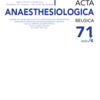Preoperative assessment of expectations, anxiety and preferences for anesthesia in patients undergoing ambulatory knee arthroscopic surgery
anesthesia ; anxiety ; arthroscopy
Published online: Mar 08 2022
Abstract
Objective : In this observational study, we aimed at measuring preoperative anxiety and preferences for anesthesia in patients undergoing knee arthroscopic surgery.
Background : Little is known about preoperative anxieties, expectations and preferences of patients undergoing surgery, for which both spinal or general anesthesia can be provided. Literature shows that spinal anesthesia is associated with lower postoperative co- morbidity and mortality rates as compared to general anesthesia (1-2). Anxiety itself is an important factor influencing patients’ outcome (3).
Methods : Every patients >18 years old undergoing an ambulatory arthroscopy of the knee in the surgical day care center of the AZ Nikolaas (in Sint-Niklaas and Beveren), was asked preoperatively to fill in a questionnaire. The questionnaire focused both on the patients’ knowledge about and preference of anesthesia, as well as their preoperative anxieties and worries. Patients were asked to score preoperative anxiety on a 5-point anxiety scale for any of 9 aspects/complications of the anesthetic (placement of the IV cannula, spinal puncture, death, awareness, pain, postoperative nausea and vomiting, cognitive impairment, infection, blood loss). During the study period, from January 11/01/ 2019 to 11/06/2019, a total of 806 patients were asked to fill out the questionnaire. 201 of these patients completed the questionnaire and were consequently enrolled in the study. This work has been approved by the Ethics Committee of the AZ Nikolaas on 11/11/2018 and by the Ethics Committee of the University Hospital in Antwerp (UZA) on 19/11/ 2018.
Results : Seventy-five % of patients had a clear preference for their anesthesia technique. Of these, 2/3 opted for general anesthesia. Patients mainly based their preference on a subjective feeling ; a minority had discussed the choice with their surgeon or general practitioner. Rarely, patients indicated the wish to talk to the anesthesiologist about their choice. Fear for a spinal puncture occurred in 40% of patients (median anxiety score 3/5, range 1-5) and was therefore the most prominent anxiety in this patient population.
Conclusions : Patients’ greater preference for general over spinal anesthesia was clearly based rather on a subjective than an objective basis. Forty 40% of patients had a substantial fear for spinal puncture. By informing patients about the risks and complications of the different anesthesia techniques, anxiety feelings can probably be alleviated, and a well-judged decision about their anesthesia technique can be made. There is room for improvement in communication and discussion between patients and anesthesiologists about the patients’ choice of anesthesia technique.
